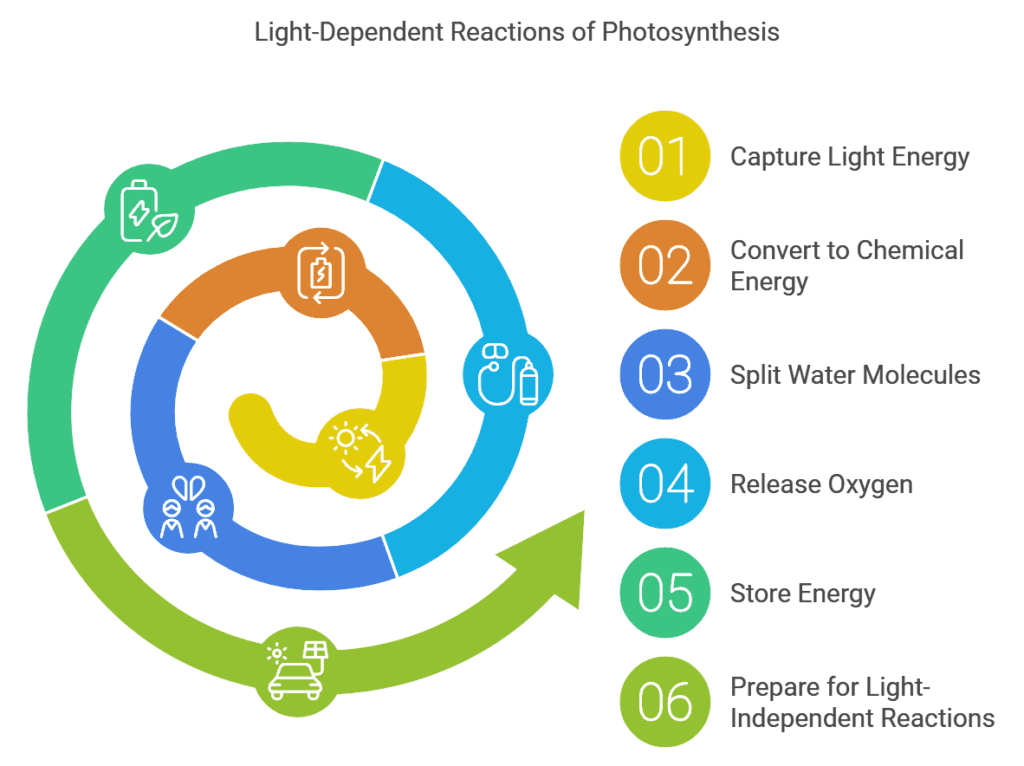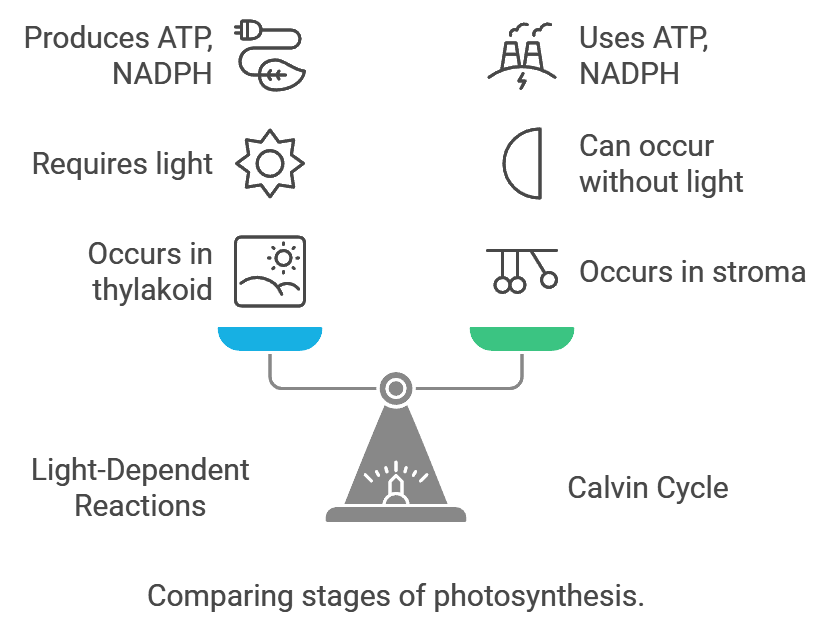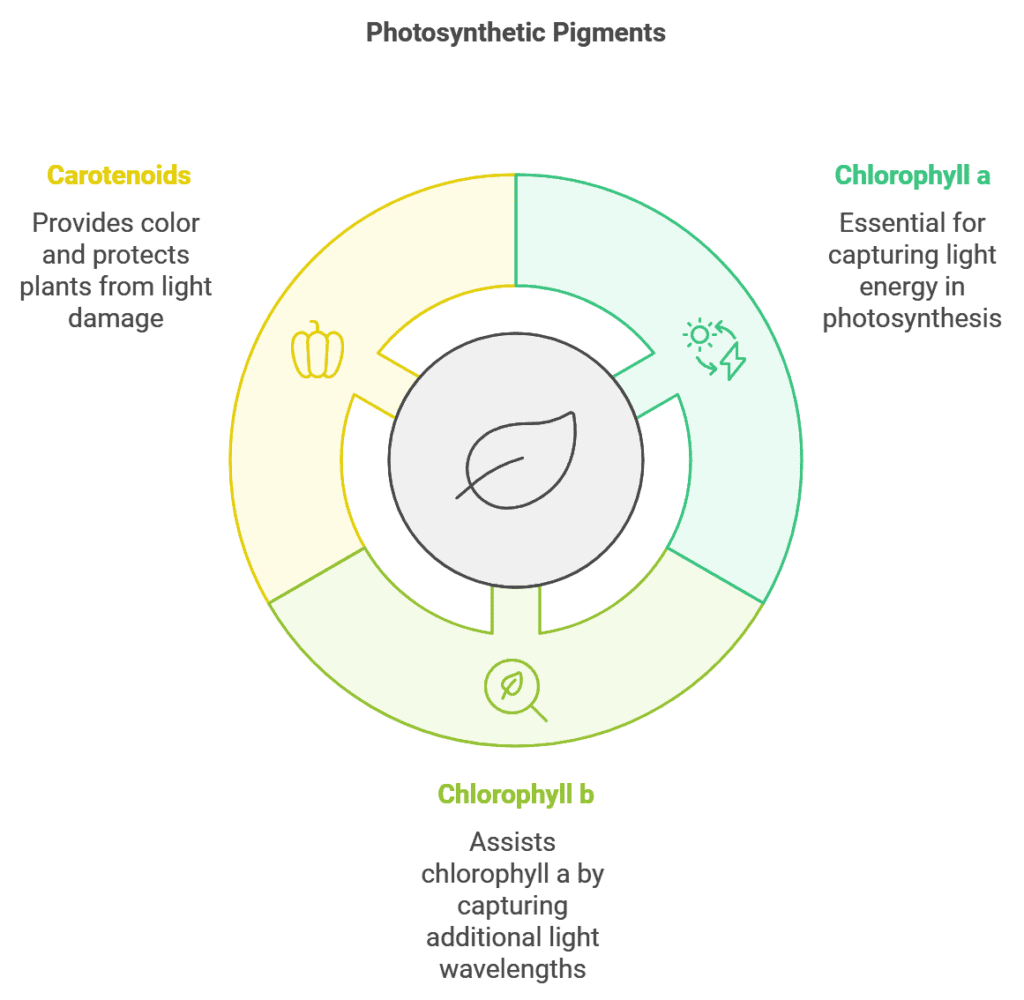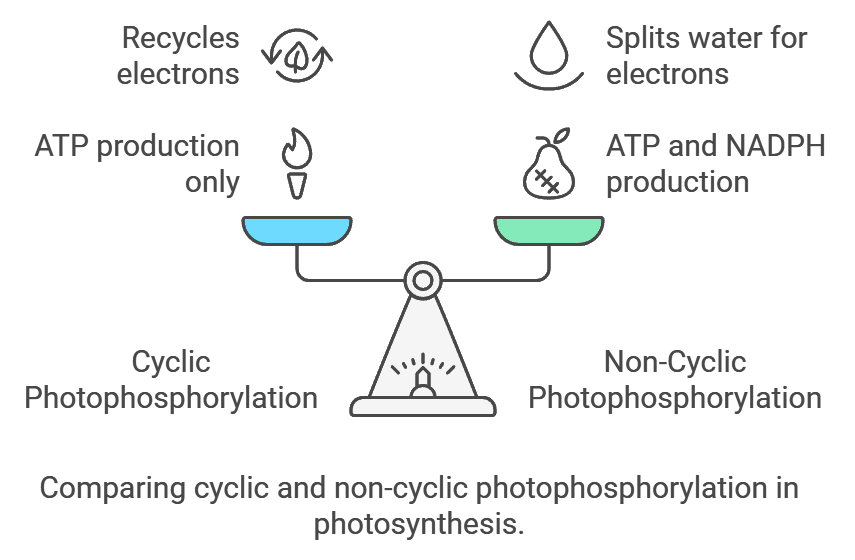The Light-Dependent Reactions of Photosynthesis: A Guide for A-Level Biology
Photosynthesis is a biological process through which plants, algae, and some bacteria convert light energy into chemical energy, powering essential life functions on Earth. The process involves two main stages: the light-dependent reactions and the light-independent (Calvin cycle) reactions. These stages work together to produce glucose and oxygen, which support plant growth and serve as energy sources for other organisms.
The light-dependent reactions play a critical role as the first step in photosynthesis, capturing solar energy and transforming it into chemical energy. This energy drives the synthesis of ATP and NADPH, essential molecules for the subsequent reactions of the Calvin cycle. Without this step, photosynthesis could not occur, and the flow of energy through ecosystems would halt.
Overview of Light-Dependent Reactions
The First Stage of Photosynthesis – The light-dependent reactions are the initial phase of photosynthesis, setting the stage for the synthesis of glucose. These reactions harness light energy to produce the chemical energy needed to drive the next steps in photosynthesis.
Location: Thylakoid Membranes of Chloroplasts
The light-dependent reactions take place within the thylakoid membranes of chloroplasts, specialized structures in plant cells. These membranes contain pigments like chlorophyll a and chlorophyll b, which absorb light and initiate the photochemical processes essential for energy conversion.
Purpose of the Light-Dependent Reactions
The purpose of the light-dependent reactions is to convert light energy into chemical energy in the form of ATP and reduced NADP (NADPH). ATP serves as the energy currency of the cell, while NADPH provides the reducing power needed for the synthesis of glucose in the Calvin cycle. Both products are essential for driving the next phase of photosynthesis.

Detailed Steps of the Light-Dependent Reactions
- Photon Absorption by Photosystem II (PSII)
The process begins when light photons hit Photosystem II (PSII), a protein-pigment complex in the thylakoid membrane. Chlorophyll molecules in PSII absorb light energy, exciting electrons to a higher energy state. - Photolysis of Water
To replace the excited electrons lost from PSII, the process of photolysis splits water molecules. This reaction produces:- Electrons to replenish those lost by PSII
- Protons (H⁺ ions), which contribute to the proton gradient
- Oxygen (O₂), released as a by-product
- Electron Transport Chain and Proton Gradient Formation
Excited electrons from PSII travel down an electron transport chain (ETC), a series of proteins embedded in the thylakoid membrane. As the electrons pass through the chain, they use their energy to pump protons (H⁺ ions) from the stroma into the thylakoid lumen, creating a proton gradient. - ATP Synthesis through Chemiosmosis
The proton gradient generated across the thylakoid membrane drives the synthesis of ATP through a process called chemiosmosis. Protons flow back into the stroma through the enzyme ATP synthase, which catalyses the conversion of ADP to ATP. - Photon Absorption by Photosystem I (PSI)
After the electrons pass through the electron transport chain, they reach Photosystem I (PSI), which re-energises them through light absorption. - Formation of NADPH
The process transfers the re-energized electrons to NADP⁺, along with protons from the stroma, forming NADPH. This molecule, along with ATP, is crucial for the Calvin cycle, where it helps drive the fixation of carbon dioxide into organic molecules.
Diagram of the Light-Dependent Reactions
Below is a visual representation of the light-dependent reactions, including the electron transport chain, photolysis, and ATP synthesis.
Comparison to the Calvin Cycle
The light-dependent reactions occur in the thylakoid membranes and require light, while the Calvin cycle takes place in the stroma and can function without direct light, as long as ATP and NADPH are available. These two stages are interdependent: the light-dependent reactions produce ATP and NADPH to fuel the Calvin cycle, which then regenerates ADP and NADP⁺, allowing the cycle to continue.

The light-dependent reactions are essential for sustaining the Calvin cycle, without which glucose synthesis would not occur. Furthermore, the oxygen produced during photolysis is vital for aerobic respiration in plants and other organisms, supporting life across ecosystems. Understanding these reactions provides insight into how plants harness energy and maintain the balance of oxygen and carbon dioxide in the atmosphere.
Key Components and Terminology of Light-Dependent Reactions
The light-dependent reactions of photosynthesis rely on several key components and specialised molecules that work together to convert light energy into chemical energy. Understanding the role of photosystems, pigments, and the electron transport chain (ETC) is essential for mastering this process.
Photosystems: Photosystem I (PSI) and Photosystem II (PSII)
Photosystems are protein-pigment complexes embedded in the thylakoid membranes of chloroplasts. They play a central role in capturing light energy and driving the electron flow required for ATP and NADPH production.
- Photosystem II (PSII):
- PSII absorbs light at a wavelength of 680 nm (hence, it is sometimes referrers to as P680).
- It initiates the light-dependent reactions by exciting electrons and splitting water molecules in a process called photolysis.
- The electrons released from PSII enter the electron transport chain to generate a proton gradient for ATP production.
- Photosystem I (PSI):
- PSI absorbs light most efficiently at 700 nm (P700).
- It re-energises electrons received from the ETC and transfers them to NADP⁺, forming NADPH.
- PSI functions later in the electron transport process, ensuring that electrons have the energy needed to drive NADPH synthesis.
Photosynthetic Pigments: Chlorophyll a, Chlorophyll b, and Carotenoids
Photosynthetic pigments absorb specific wavelengths of light, initiating the energy capture needed for photosynthesis. Located in photosystems, these pigments play a vital role in gathering light energy.
- Chlorophyll a:
- The primary pigment involved in photosynthesis.
- It directly participates in the light-dependent reactions by transferring energy to the reaction centres of PSII and PSI.
- Chlorophyll a absorbs light in the blue-violet and red regions of the spectrum.
- Chlorophyll b:
- An accessory pigment that broadens the range of light absorption by capturing blue and orange wavelengths.
- It transfers the absorbed energy to chlorophyll a, enhancing the efficiency of photosynthesis.
- Carotenoids (Beta-Carotene and Xanthophyll):
- Carotenoids are accessory pigments that absorb light in the blue-green region and protect chlorophyll from photo-damage by dissipating excess energy.
- Beta-carotene and xanthophyll contribute to light absorption and also function as antioxidants, protecting the plant from oxidative stress.
Together, these pigments ensure that plants capture as much light energy as possible across a broad spectrum, maximising photosynthetic efficiency.

Electron Transport Chain (ETC)
The electron transport chain (ETC) is a series of proteins embedded in the thylakoid membrane. Its primary function is to facilitate electron movement from PSII to PSI while generating a proton gradient for ATP synthesis.
- Electron Movement:
- Electrons excited by light energy in PSII are transferred to the ETC.
- As these electrons move along the chain, they release energy, which is used to pump protons (H⁺) from the stroma into the thylakoid lumen, creating a proton gradient.
- ATP Production:
- The proton gradient drives chemiosmosis, where protons flow back into the stroma through ATP synthase, generating ATP from ADP and inorganic phosphate.
- Electron Re-Energisation in PSI:
- After electrons pass through the ETC, they reach PSI, which re-energises them through light absorption.
- These high-energy electrons then reduce NADP⁺ to NADPH, completing the light-dependent reactions.
The ETC ensures a continuous flow of electrons, maintaining the energy production necessary for the Calvin cycle to synthesize glucose in the light-independent reactions.
Stages of the Light-Dependent Reaction
The light-dependent reactions of photosynthesis involve a series of interconnected processes that convert solar energy into chemical energy. Each step plays a critical role in producing ATP and NADPH, which fuel the Calvin cycle. The following section breaks down the stages in detail.
Absorption of Light Energy (PSII)
The process begins when light photons strike Photosystem II (PSII), causing electrons in chlorophyll to become excited in a reaction known as photoionisation.
- Light energy excites electrons in chlorophyll molecules, raising them to a higher energy level.
- The excited electrons leave PSII and travel through the electron transport chain (ETC).
- As these electrons move through the ETC, they release energy used to pump protons (H⁺) across the thylakoid membrane.
Photolysis of Water
To maintain electron flow, PSII replaces the lost electrons by splitting water molecules, a process called photolysis.
- Water (H₂O) is broken down into oxygen (O₂), protons (H⁺), and electrons.
- The oxygen is released as a by-product into the atmosphere, supporting aerobic life.
- The electrons produced replace those lost from PSII, ensuring the system can continue absorbing light and energising electrons.
Proton Gradient Formation and ATP Production
As electrons move through the electron transport chain, they use their energy to pump protons (H⁺) from the stroma into the thylakoid lumen, creating a proton gradient across the membrane.
- This gradient stores potential energy, with more protons concentrated inside the lumen than in the stroma.
- The ATP synthase enzyme uses the energy of protons flowing back into the stroma (via chemiosmosis) to synthesise ATP from ADP and inorganic phosphate (Pi).
Transfer of Electrons to PSI and Formation of NADPH
Electrons travelling along the electron transport chain eventually reach Photosystem I (PSI).
- PSI also absorbs light energy, re-energising the electrons to an even higher energy level.
- These high-energy electrons are used to reduce NADP⁺ to NADPH by combining with protons (H⁺) from the stroma.
- NADPH, along with ATP, serves as essential energy carriers for the Calvin cycle (light-independent reactions).

Non-Cyclic Photophosphorylation
Non-cyclic photophosphorylation is the primary pathway in light-dependent reactions, involving both Photosystem II (PSII) and Photosystem I (PSI). It ensures the production of ATP and NADPH, both of which are essential for driving the Calvin cycle.
- Process:
- Light excites electrons in PSII, raising them to a higher energy level.
- The excited electrons pass through the electron transport chain (ETC), generating ATP via chemiosmosis.
- Electrons are then transferred to PSI, where they are re-energised by light absorption.
- Finally, the electrons reduce NADP⁺ to NADPH with the help of protons from the stroma.
- Products:
- ATP and NADPH are both generated.
- Oxygen is released as a by-product from the photolysis of water.
Non-cyclic photophosphorylation provides the energy and reducing power necessary for the Calvin cycle, but it may not always produce enough ATP to meet all cellular demands.
Cyclic Photophosphorylation
Cyclic photophosphorylation involves only Photosystem I (PSI) and generates ATP without producing NADPH. This process ensures that the chloroplast has sufficient ATP for various metabolic processes when the demand for NADPH is lower.
- Process:
- Light excites electrons in PSI, raising them to a higher energy level.
- Instead of being transferred to NADP⁺, the electrons cycle back to the ETC, returning to PSI.
- As electrons move through the ETC, they drive ATP synthesis via chemiosmosis.
- Products:
- ATP is produced, but no NADPH or oxygen is generated.
Cyclic photophosphorylation serves as a backup mechanism to ensure the plant cell produces enough ATP, especially during times when the Calvin cycle requires more ATP than NADPH.
Comparison of Cyclic and Non-Cyclic Photophosphorylation
| Feature | Non-Cyclic Photophosphorylation | Cyclic Photophosphorylation |
| Photosystems Involved | PSII and PSI | PSII Only |
| ATP Production | Yes | Yes |
| NADPH Production | Yes | No |
| Oxygen Production | Yes | No |
| Purpose | Produces ATP and NADPH for the Calvin cycle | Ensures adequate ATP supply when NADPH is not needed |
Chemiosmotic Theory: How ATP is Generated
Peter Mitchell proposed the chemiosmotic theory to explain how ATP is synthesised during the light-dependent reactions of photosynthesis. This process relies on protons (H⁺ ions) moving across a membrane, creating a proton gradient that drives ATP production. The Calvin cycle (light-independent reactions) later uses this ATP to synthesise glucose.
How Chemiosmosis Works in Photosynthesis
- Proton Gradient Formation:
- During the light-dependent reactions, electrons excited by light energy move through the electron transport chain (ETC) in the thylakoid membrane.
- As these electrons pass through the chain, energy is released, which pumps protons (H⁺ ions) from the stroma into the thylakoid lumen.
- This creates a proton gradient with a higher concentration of protons inside the thylakoid lumen compared to the stroma.
- Proton Flow Through ATP Synthase:
- Protons naturally move down their concentration gradient, flowing back into the stroma through the enzyme ATP synthase.
- As protons pass through ATP synthase, the energy released drives the conversion of ADP and inorganic phosphate (Pi) into ATP.
Role of ATP in the Calvin Cycle
The ATP generated through chemiosmosis plays a vital role in the Calvin cycle, where it powers the conversion of carbon dioxide into glucose. Without the ATP produced during the light-dependent reactions, the Calvin cycle would not have the energy required for carbon fixation and sugar synthesis.
Importance of the Light-Dependent Reaction
The light-dependent reaction plays a crucial role in the photosynthetic process, ensuring that plants produce the necessary energy and reducing power for the subsequent stages of photosynthesis. Beyond its function in the plant, this reaction also contributes to the maintenance of environmental oxygen levels, supporting life on Earth.
1. Provides Energy and Reducing Power for the Calvin Cycle
The Calvin cycle (light-independent reaction) relies on the products of the light-dependent reaction to drive the conversion of carbon dioxide into glucose.
- ATP: Serves as the energy currency for the Calvin cycle, powering reactions like the regeneration of RuBP (ribulose-1,5-bisphosphate) and the fixation of CO₂.
- NADPH: Acts as a reducing agent, donating high-energy electrons required to reduce carbon intermediates into sugars. Without a steady supply of ATP and NADPH, the Calvin cycle cannot proceed, halting glucose production.
2. Maintains Oxygen Levels Through Photolysis of Water
The light-dependent reaction is responsible for producing oxygen through photolysis, the splitting of water molecules.
- As part of this process, oxygen (O₂) is released into the atmosphere as a by-product.
- This oxygen supports aerobic respiration in plants, animals, and other organisms, maintaining the balance of gases necessary for life on Earth.
If you prefer to listen information about The Light-Dependent Reactions of Photosynthesis, you can explore this topic
Conclusion
The light-dependent reaction plays a vital role in photosynthesis, providing the essential ATP and NADPH needed to drive the light-independent reactions (Calvin cycle) for glucose production. Additionally, the oxygen released through photolysis supports environmental sustainability by maintaining atmospheric oxygen levels essential for life.
For students seeking a deeper understanding of these interconnected processes, our A-Level Biology Tutors can provide personalized support. Platforms like Edumentors connect learners with experienced online tutors who help clarify complex concepts and guide exam preparation. Mastering the intricacies of photosynthesis not only strengthens biology knowledge but also builds a solid foundation for success in A-level assessments and beyond.








